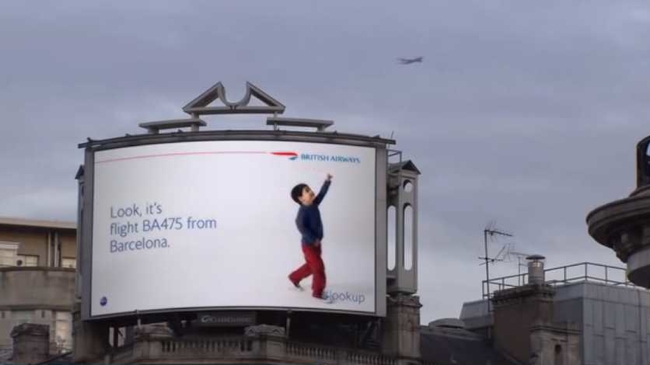
 BA interactive poster
BA interactive poster
What happens when you connect a giant digital poster to the internet?
Digital advertising - through the medium of digital signage - was supposed to be enjoying a golden era. Flat, high definition video screens, all connected to an "intelligent" network, were supposed to be the future. Some people (including me) were predicting that a visit to a shopping mall would be like being inside a web browser, with every surface carrying information or advertising, and your every thought and desire reflected in the content of the screens that surround you.
We were wrong. And it's probably a good thing.
First, it's expensive. Especially outdoors, which remains a specialist market for high-luminosity LED screens.
Then, it consumes a lot of power. Having floor-to-ceiling video doesn't exactly encourage the view that whoever owns the shopping mall is trying to save energy, and hence the Earth.
Finally (well, not finally, actually: there are many more reasons), it's just not that effective. Especially because a far more engaging medium has just emerged in the form of smartphones. Almost everyone has one of these and they have all the characteristics that digital signage has tried but largely failed to achieve. They're convenient, ubiquitous, and they're always connected. What's more, they're completely personal. Annoyingly for retailers, they're often the enemy rather than a friend: users are more likely to use their smartphones in-store to look for the prices offered by competitors than they are to check out your own special offers.
Digital Signage has largely failed
So Digital Signage has largely failed to achieve the potential that was hoped for (by some!) five or six years ago. At times, and in specific niches like Electronic Wayfinding, it is invaluable, but for most of us - especially when existing installations are old or the content is not updated - the idea is decidedly meh!
High profile outdoor digital advertising, though, is a different matter. Advertising agencies (and through them, their clients) pay millions for prime sites. And to justify this - and to attract sufficient numbers of eyeballs - they want their content to be as impressive as possible.
The best example we've seen yet is the new British Airways campaign at Piccadilly Circus in Central London and at the M4 flyover in Chiswick, West London, not far from Heathrow Airport.
The idea pulls together all that net-connected digital signage originally promised and turns it into a unique ad that is incredibly compelling.
When a BA flight passes over the display (a pretty frequent occurrence in London!) a child walks across the screen and points towards the sky. If you follow the line of the child's finger approximately, you'll see the aircraft.
At the same time, text appears to the left of the child, saying "Look, it's flight BA475 from Barcelona" or whatever details are relevant to the current plane.
Clever
How does it work? Flight data is widely available on the web - especially, of course, to an airline. The on-screen action is triggered by a notification from the flight data system. It's probably quite a simple thing to integrate, but quite another thing to do so as effectively as this.
Perhaps this is a lesson in effective dynamic advertising: try to amaze and perplex your audience and at the same time give them real, unique data. After all: why not? It's all out there. The same sort of thing has been available in Augmented Reality apps for smartphones for a number of years now.
We give this our vote for the slickest outdoor advertising campaign ever.
Watch the video after the break
Tags: Technology


Comments